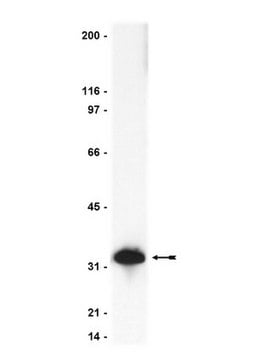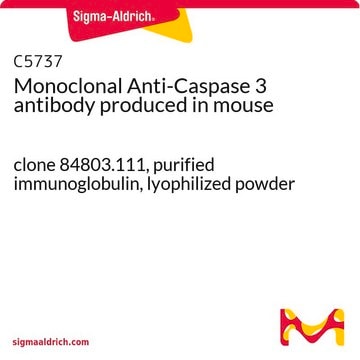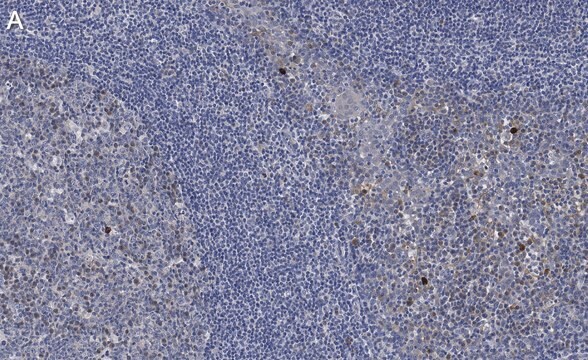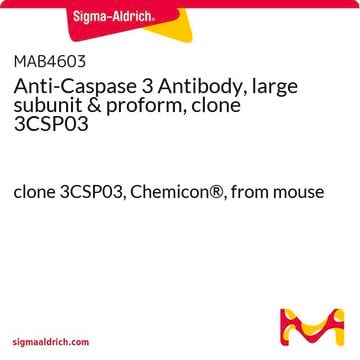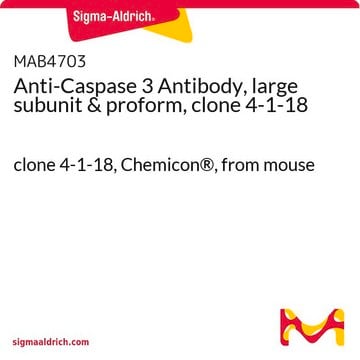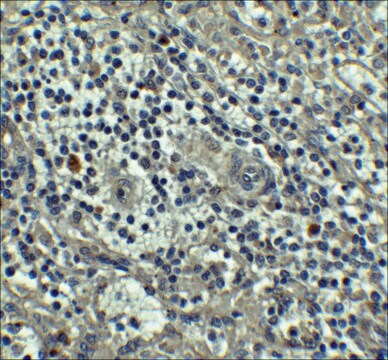Kluczowe dokumenty
C8487
Anti-Caspase 3, Active antibody produced in rabbit
IgG fraction of antiserum, buffered aqueous solution
Synonim(y):
Aktywowane przeciwciało przeciwko kaspazie 3 - Aktywne przeciwciało przeciwko kaspazie 3 produkowane u królików, Przeciwciało aktywowanej kaspazy 3
About This Item
Polecane produkty
pochodzenie biologiczne
rabbit
Poziom jakości
białko sprzężone
unconjugated
forma przeciwciała
IgG fraction of antiserum
rodzaj przeciwciała
primary antibodies
klon
polyclonal
Formularz
buffered aqueous solution
reaktywność gatunkowa
rat, bovine, human, pig, canine, mouse
opakowanie
antibody small pack of 25 μL
metody
indirect immunofluorescence: 1:1,000 using human epitheloid carcinoma HeLa cell line, treated with staurosporine
microarray: suitable
western blot: 1:500 using recombinant human caspase 3, active (Sigma Product No. C1224)
numer dostępu UniProt
Warunki transportu
dry ice
temp. przechowywania
−20°C
docelowa modyfikacja potranslacyjna
unmodified
informacje o genach
human ... CASP3(836)
mouse ... Casp3(12367)
rat ... Casp3(25402)
Opis ogólny
Immunogen
Zastosowanie
- for western blotting of cytochrome c for caspase activation
- as primary antibody in immunofluorescence staining of embryos and postnatal mice cryosections
- in Western blot analysis of activated caspase 3
- as a primary antibody in immunodetection of rat brain sections
Działania biochem./fizjol.
Postać fizyczna
Przechowywanie i stabilność
Oświadczenie o zrzeczeniu się odpowiedzialności
Nie możesz znaleźć właściwego produktu?
Wypróbuj nasz Narzędzie selektora produktów.
polecane
Kod klasy składowania
12 - Non Combustible Liquids
Klasa zagrożenia wodnego (WGK)
nwg
Temperatura zapłonu (°F)
Not applicable
Temperatura zapłonu (°C)
Not applicable
Wybierz jedną z najnowszych wersji:
Certyfikaty analizy (CoA)
Nie widzisz odpowiedniej wersji?
Jeśli potrzebujesz konkretnej wersji, możesz wyszukać konkretny certyfikat według numeru partii lub serii.
Masz już ten produkt?
Dokumenty związane z niedawno zakupionymi produktami zostały zamieszczone w Bibliotece dokumentów.
Klienci oglądali również te produkty
Active Filters
Nasz zespół naukowców ma doświadczenie we wszystkich obszarach badań, w tym w naukach przyrodniczych, materiałoznawstwie, syntezie chemicznej, chromatografii, analityce i wielu innych dziedzinach.
Skontaktuj się z zespołem ds. pomocy technicznej
